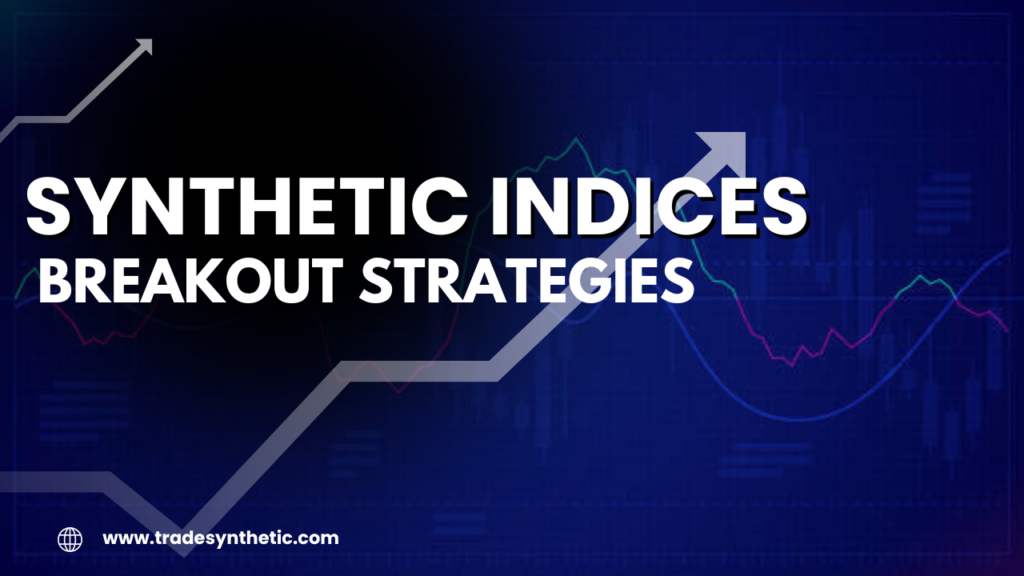Synthetic indices have become an attractive asset class for traders seeking high volatility and 24/7 market opportunities. A breakout strategy, one of the most effective methods in synthetic indices trading, focuses on identifying price levels where significant movement is expected. If you’re looking for a trading strategy that takes advantage of synthetic indices, a breakout strategy might be your perfect ally.
This article will help you know how to develop great synthetic indices breakout strategy, the tools required, and actionable tips to improve your trading results.
What Are Synthetic Indices?
Synthetic indices are financial instruments that mimic real-world market behaviors without being tied to any physical assets. These instruments are often traded through brokers like Deriv, offering continuous trading opportunities and consistent volatility.
Synthetic indices are particularly popular among traders because they are immune to external factors like economic news, ensuring fair and predictable market conditions.
What is a breakout Strategy?
A breakout strategy involves identifying and acting upon price levels where the market is expected to break out of a defined range. The breakout can occur in either direction, up or down, depending on market conditions. This strategy is particularly effective for synthetic indices due to their high volatility and predictable price movements.
Elements of Synthetic Indices breakout strategy
-
Identifying Support and Resistance Levels
Breakouts occur when the price crosses key support or resistance levels. These levels can be identified using historical price data and technical analysis tools.
-
Volume Confirmation
In traditional markets, volume often confirms breakout strength. While synthetic indices lack volume data, you can use volatility indicators to confirm breakout momentum.
-
Entry and Exit Points
Determine precise entry points for trades based on breakout signals and plan exit strategies using stop-loss and take-profit orders.
-
Risk Management
Effective breakout strategies require strict risk management rules to minimize losses.
Top Tools and Indicators for Breakout Trading
To succeed with a breakout strategy, you need reliable tools and indicators. Using these tools in allows you to confirm breakout signals and avoid false breakouts. Here are some of the essential tools:
-
Moving Averages
Moving averages help identify trends and act as dynamic support and resistance levels.
-
Bollinger Bands
Bollinger Bands are excellent for identifying periods of low volatility before a breakout.
-
Relative Strength Index (RSI)
The RSI helps determine whether an asset is overbought or oversold, offering clues about potential breakouts.
-
ATR (Average True Range)
ATR is crucial for setting stop-loss and take-profit levels as it measures market volatility.
-
Trendlines
Drawing trendlines on charts can help visualize potential breakout points.
Step-by-Step Guide to a Synthetic Indices Breakout Strategy
1. Analyze the Market
Start by identifying the synthetic index you want to trade, such as Volatility 75 Index, Crash 500 Index, or Boom 1000 Index. Use a higher timeframe (e.g., 4-hour or daily charts) to identify key support and resistance levels.
2. Monitor Volatility
Switch to a lower timeframe (e.g., 1-hour or 15-minute charts) to observe periods of low volatility. Use Bollinger Bands to identify when the price is consolidating, as this often precedes a breakout.
3. Set your entry Points
Place buy-stop or sell-stop orders slightly above or below the consolidation zone. This ensures that your trade is triggered only when the price breaks out in the expected direction.
4. Manage Risk
Set your stop-loss orders just below support for long trades or above resistance for short trades. Use the ATR indicator to calculate appropriate stop-loss levels based on current market volatility.
5. Exit Strategies
Define your take-profit levels based on risk-reward ratios, such as 1:2 or 1:3. Use trailing stop-loss orders to lock in profits as the trade moves in your favor.
6. Evaluate your Performance
After executing the trade, review your performance. Analyze what worked well and what didn’t to refine your strategy for future trades.
Risk Management in Synthetic Indices Breakout Trading
Given the volatility of synthetic indices, traders must exercise caution. Some of the risk Management Tips include:
-
Set Stop-Loss Orders
Protect your capital by setting stop-loss levels close to your entry point.
-
Use Proper Position Sizing
Never risk more than 1-2% of your trading capital on a single trade.
-
Diversify Trades
Avoid overexposure to a single index.
-
Evaluate Performance
Always make sure you regularly review and adjust your strategy.
Common Mistakes to Avoid in Breakout Synthetic Indices Trading
-
Ignoring False Breakouts
Not all breakouts lead to significant price movements. Always wait for confirmation before entering a trade.
-
Overtrading
Avoid taking every breakout signal; focus on high-probability setups.
-
Poor Risk Management
Ensure you stick to your pre-defined stop-loss and take-profit levels.
-
Neglecting Technical Analysis
Use multiple indicators for confirmation to avoid relying on a single tool.
Advantages and Limitations of Breakout Strategies
Advantages of Synthetic Indices Breakout Strategies
-
Scalability
Suitable for traders with varying capital sizes.
-
High Potential Returns
Breakouts can lead to significant price movements.
-
Simplicity
Easy to learn and implement.
Limitations of Synthetic Indices Breakout Strategies
-
False Breakouts
Markets may occasionally fake a breakout, leading to losses.
-
High Volatility Risk
Sudden reversals in synthetic indices can be challenging.
Conclusion
The market is so volatile and as such synthetic indices breakout strategy has become a powerful strategy for traders looking to capitalize on.
As a trader, your responsibility is to understand support and resistance levels, using the right tools and indicators, and following a structured trading plan, when you do this, you can improve your chances of success.
Always remember to manage risk effectively and continuously refine your strategy based on performance reviews.
Frequently Asked Questions FAQs
1. What is the best timeframe for breakout trading in synthetic indices?
- The ideal timeframe depends on your trading style. Day traders may prefer 15-minute or 1-hour charts, while swing traders often use 4-hour or daily charts.
2. How do I avoid false breakouts?
- Wait for confirmation using indicators like Bollinger Bands, RSI, or ATR. You can also look for candlestick patterns that confirm the breakout.
3. Can I use this strategy on all synthetic indices?
- Yes, this strategy is versatile and works on various synthetic indices, including Volatility 75 Index and Boom and Crash indices.
4. What is the minimum capital needed to trade synthetic indices?
- The minimum capital depends on your broker and the specific index. Ensure you have sufficient funds to accommodate your risk management rules.
5. Are synthetic indices trading suitable for beginners?
- While synthetic indices offer great opportunities, their high volatility makes them risky for beginners. Start with a demo account to practice before trading with real money.










